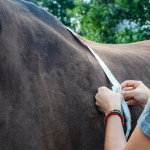Horse Health: Are You Getting the Best Reading from Your Weight Tape?

Weight tapes can be valuable tools in the fight for weight gain or the battle against the bulge. While some studies show that weight tapes may not always give an accurate reading—the heavier the horse, the greater the likelihood of imprecision—they are nevertheless worthwhile in tracking changes in weight over time.
Catherine Whitehouse, M.S., a nutrition advisor at Kentucky Equine Research, lends her expertise with these weight-tape tips.
Find a level surface and return to that surface every time the horse is measured. In an ideal world, a level concrete or asphalt pad is the best place to use a weight tape, Whitehouse explained. Many facilities have these surfaces in grooming areas or in dedicated farrier or veterinarian spaces. Any level place with firm footing will do, however. “Avoid muddy areas or other places with unsure footing, as a balanced stance and an accurate measurement are more difficult to achieve,” she said.
Acclimate the horse to the tape, especially if it is sensitive about being touched on its belly. Most horses used for riding and driving will have no issue with a weight tape crossing their withers or circling their barrel. Young horses or those that are especially sensitive or wary may need more time to become familiar with the sensation. With time and patience, most will get accustomed to the weight tape.
Read the instructions on the tape to determine tautness. Defining how much pressure to place on the tape to reach a final reading depends largely on the manufacturer’s instructions. Generally, weight tapes are neither pulled tightly nor allowed to hang loosely. “Once you’ve decided how much pressure to apply, try to memorize that feel, as you’ll want to use the same amount each time you use the weight tape,” Whitehouse recommended.
Allow the horse to become settled before using the weight tape. If possible, tie the horse in a familiar place or have an experienced horseperson hold the horse. Encourage the horse to stand square, or nearly so, with his head in a relaxed position.
Recognize breathing patterns. Spend time with your horse, learning how to measure respiration rate and becoming comfortable distinguishing the two phases of respiration: inspiration and expiration. Do you know the normal resting respiration rate for a mature horse? (The answer is in the footnote.) Inspiration pulls the ribs away from the midline, increasing the width of the thoracic cavity.* If possible, take the weight-tape measurement immediately after the horse exhales, when the ribs are collapsed.
Come up with a schedule and stick with it. Using a weight tape regularly is key to monitoring weight gain or loss. Weigh the horse every three to five weeks, or create a similar schedule that’s best for you. Some horse owners weigh their horses the first of each month or every time the farrier comes. Record weights in a small notebook that is stored with the weight tape. Keep a pen handy, too! Nearsighted? Toss in an old pair of readers, as those lines and numbers on the tape can be difficult to read.
Implementing results. If you’re happy with your horse’s weight and his weight changes little from one reading to the next, all is well. If the weight tape shows significant variation over time—coupled with some physical changes—it may be time to evaluate the diet. Enlist the help of a professional nutritionist to review the diet.
In addition to tracking weight, having a weight tape on-hand is important when you must calculate dosage of some medications, including dewormers or vet-recommended pain-relievers. “Regularly using a weight tape is just another way to become more familiar with your horse. If ever possible, have the horse weighed on a calibrated electronic scale,” suggested Whitehouse. “Compare the two weights—one from the weight tape and one from the scale—and note the difference.”
Answer to quiz question: The normal resting respiration rate of mature horses is 8-15 breaths per minute.
*Ainsworth, D.M., and R.P. Hackett. 2004. Disorders of the respiratory system. In: S.M. Reed, W.M. Bayly, and D.C. Sellon, editors, Equine internal medicine. Saunders, St. Louis, MO. p. 137.








